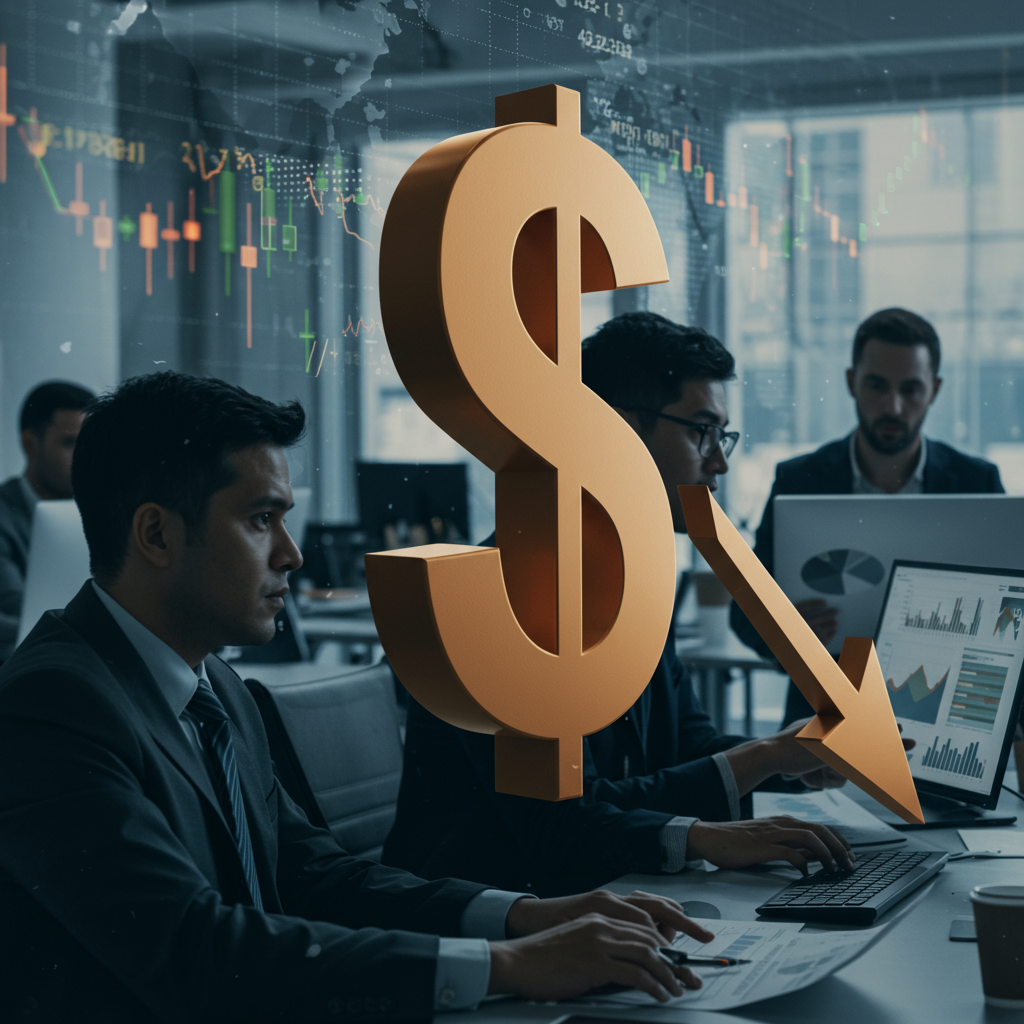The U.S. dollar has faced an unprecedented challenge this year, experiencing its most significant decline in over half a century. This sharp weakening isn’t just a statistic; it ripples through global markets, impacts travel costs, influences trade dynamics, and sparks serious discussion about the future of the American currency’s global dominance. Experts point to a confluence of factors, heavily influenced by specific policies and economic conditions, as the driving forces behind this surprising start to 2025. Understanding these underlying causes is essential for grasping the potential trajectory of the dollar and its broader economic implications.
Decoding the dollar’s Steep Slide
The U.S. dollar index, which tracks the greenback against a basket of other major world currencies like the euro and yen, recorded a striking 10.8% fall through the first half of the year. This represents the dollar’s worst performance since the early 1970s, a period marked by the dramatic end of the Bretton Woods system where the dollar’s convertibility to gold was formally canceled. While the dollar had been exceptionally strong coming into the year, reaching a 25-year high, the scale and speed of the subsequent decline have caught global attention. This volatility raises questions about underlying shifts in investor confidence and global economic perceptions.
Trump’s Trade Policies as a Key Catalyst
According to experts like Harvard economics professor Kenneth Rogoff, former chief economist at the IMF, President Trump’s policies have acted as a major “catalyst” for the dollar’s decline. The administration’s unpredictable approach to trade, characterized by “stop-start tariff wars,” has created significant uncertainty in the global economy. Threats to impose taxes on foreign investment and a general climate suggesting that investing in the United States might not be as secure as it once was have directly impacted investor sentiment.
Specific actions, such as the unveiling of tariffs on imports from numerous countries in April 2025 (dubbed “Liberation Day” by Trump), have reportedly triggered massive selloffs in U.S. financial assets. Over $5 trillion was wiped from the S&P 500 index value in just three days following this announcement, and U.S. Treasuries also experienced significant selloffs. While some tariffs were later paused, investor wariness persists. This “disordered strategy” contrasts with the typical expectation that import tariffs should strengthen a currency; instead, it seems the resulting instability and fear of market disruption have had the opposite effect on the dollar.
Concerns Over National Debt and Fiscal Health
Another critical factor driving dollar weakness is growing concern over the U.S. national debt and fiscal policy. Rogoff describes the U.S. debt situation as “off the rails,” noting that the debt-to-income ratio is fast approaching the post-World War Two record high. Foreign investors are particularly worried about the sustainability of this debt trajectory, especially given a perceived lack of a clear plan to address the issue.
The proposed “One Big Beautiful Bill Act,” currently debated in Congress, is a focal point of this concern. This legislation, aiming to extend 2017 tax cuts and potentially reduce healthcare and welfare spending, is projected by the non-partisan Congressional Budget Office (CBO) to add a staggering $3.3 trillion to the federal debt by 2034. Such projections exacerbate worries about rising deficits and the debt-to-GDP ratio. This fiscal uncertainty makes U.S. Treasury bonds, traditionally seen as a safe haven, less attractive to international buyers, putting further downward pressure on the dollar.
Pressure on the Federal Reserve
President Trump’s open criticism and pressure on the Federal Reserve to lower interest rates also contribute to the dollar’s volatility. Trump has questioned the Fed’s independence and decision-making, particularly under Chair Jerome Powell, arguing that higher rates are unnecessarily hindering economic growth and increasing borrowing costs. Expectations of potential Fed rate cuts, reportedly urged by Trump to support the economy, tend to weaken a currency as lower rates make dollar-denominated assets less appealing compared to those in countries with higher returns.
While the Fed, under Powell, has expressed a preference to wait for more economic data before adjusting policy, especially to assess the impact of tariffs on inflation, the tension between the administration’s desires and the central bank’s cautious approach adds another layer of uncertainty perceived by investors.
The Consequences of a Weaker Dollar
A declining dollar has varied impacts depending on where you stand in the global economy. For Americans traveling abroad, it means their dollars buy less, making foreign goods and services more expensive. Similarly, it increases the cost of imports for U.S. consumers and businesses, potentially contributing to inflation.
However, a weaker dollar significantly benefits U.S. exporters. American goods and services become cheaper and more competitive on the international market. This includes substantial U.S. exports like insurance, consulting, finance, and intellectual property, which are typically priced in dollars. On the other hand, for individuals sending remittances from the U.S. to family overseas, the weaker dollar means the foreign currency they receive in exchange is worth less. Developing countries holding dollar-denominated debt see a silver lining, as a weaker dollar reduces the cost of repaying those obligations. A weaker dollar can also contribute to rising commodity prices globally.
The Dollar as a Global Referendum
Ultimately, the dollar’s value serves as a powerful “referendum” on how global investors perceive the overall strength, stability, and future outlook of the U.S. economy and its governance. The current weakness is seen worldwide as a signal that confidence in U.S. markets and even its legal/political system under the current administration is weakening.
While the dollar remains the dominant anchor currency globally, accounting for large shares of international trade, finance, and foreign reserves, signs of shifting sentiment are appearing. Central banks, for instance, have notably increased their gold purchases, reaching record highs, partly due to worries about the potential devaluation of their significant dollar holdings. Experts suggest investors may be realizing they are overexposed to U.S. assets, leading to potential trimming of positions and continued pressure on the dollar. Some argue the U.S. has become a “less attractive place to invest.”
Frequently Asked Questions
Why did the U.S. dollar fall so sharply this year?
The dollar’s significant decline this year, the worst start in over 50 years, is primarily linked to President Trump’s policies and growing concerns about U.S. debt. Trump’s unpredictable trade wars and perceived pressure on the Federal Reserve have created market uncertainty and reduced the perceived safety of investing in the U.S. Additionally, worries about the ballooning national debt, exacerbated by proposed legislation like the “One Big Beautiful Bill Act,” have made U.S. assets less appealing to foreign investors.
How does a weaker dollar affect different people and countries?
A weaker dollar makes international travel and imported goods more expensive for Americans. Conversely, it makes U.S. exports, including services like finance and technology, cheaper and more competitive globally, benefiting U.S. exporters. For individuals sending money abroad, remittances are worth less in foreign currency. Developing countries with debt in U.S. dollars benefit from lower repayment costs, and commodity prices can see upward pressure.
Is the U.S. dollar losing its status as the world’s main reserve currency?
While the dollar’s recent weakness is significant and represents potentially the biggest shift in over 50 years (compared to the 1971 Nixon shock), experts currently see no immediate threat to its status as the dominant world currency. However, the decline reflects increasing global wariness. Central banks are increasing gold reserves, and investors are re-evaluating their exposure to U.S. assets, suggesting a potential, albeit slow, trend of diversifying away from dollar dependence if current policy directions continue.
Looking Ahead: An Inflection Point?
Many observers, including Kenneth Rogoff, characterize the current situation as a potential “inflection point” in global economic history. The magnitude of this dollar weakening hasn’t been seen since the turbulent 1970s following major shifts in the global financial system. While the dollar remains dominant, the confluence of unpredictable trade policies, escalating debt concerns, and perceived challenges to institutional independence like the Fed are prompting a global reassessment. The long-term consequences of a potentially diminished role for the U.S. dollar could be substantial and costly, impacting everything from borrowing costs to America’s influence on the world stage. The trajectory for the remainder of the year and beyond will likely depend on the evolution of these key policy areas and the market’s reaction to continued uncertainty.




